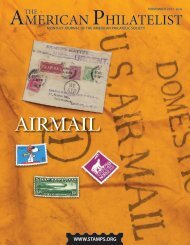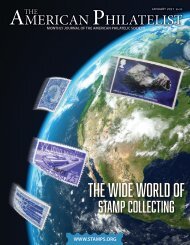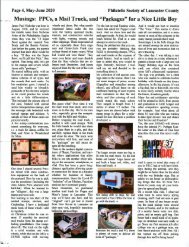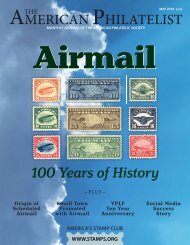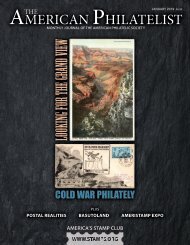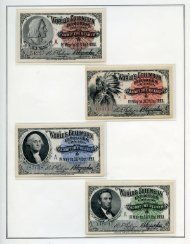The American Philatelist April 2020
Holocaust Rememberance Issue
Holocaust Rememberance Issue
You also want an ePaper? Increase the reach of your titles
YUMPU automatically turns print PDFs into web optimized ePapers that Google loves.
Figure 3. A picture post card of the park and athletic field at Lipowa<br />
7 before WWII.<br />
muted to the camp, taking their own tools with them. However,<br />
in the summer of 1940, the SS confined the laborers to<br />
the camp barracks, because many of the workers did not show<br />
up to work when they were supposed to or sent someone in<br />
their place.<br />
First and foremost, Lipowa 7 was a work and penal camp<br />
for Polish and Jewish prisoners. Lipowa 7 also occasionally<br />
functioned as a transit camp where Nazis gathered slave laborers<br />
before shipping them off to other labor outposts. Due<br />
to overcrowding, some transports arriving at the camp resulted<br />
either in immediate work-selections or death for the<br />
prisoners not fit to work. Only prisoners capable of working<br />
were allowed to stay in Lipowa.<br />
In December 1940 the SS Company Deutsche Ausrüstungswerke<br />
(DAW — German Equipment Works) or DAW<br />
Lindenstrasse (Lipowa Street) took over Lipowa 7. DAW was<br />
a German defense contractor with headquarters in Berlin,<br />
owned and operated by the Schutzstaffel. It consisted of a<br />
network of factories and camp workshops across Germanoccupied<br />
Europe, exploiting the prisoner slave labor from<br />
all Nazi concentration camps. This firm maintained the<br />
craft workshops in Lipowa 7. <strong>The</strong> slaves in Lipowa were also<br />
farmed out to other SS factories for work.<br />
In July 1941, Reichsführer-SS Heinrich Himmler visited<br />
Lublin. One result of this visit was the transfer in October<br />
1941 of several hundred prisoners from Lipowa 7 to work<br />
on the construction of the concentration camp at KL Lublin.<br />
Another group of Lipowa camp inmates was employed at the<br />
construction of the Flugplatz (Airfield) labor camp. After the<br />
commencement of Aktion Reinhardt, in which mass-killing<br />
extermination camps, including Treblinka and Bełżec, were<br />
built in Poland, Lipowa laborers had to unload and sort the<br />
goods brought directly from death camps. Aktion Reinhardt<br />
was a result of the Wannsee Conference in January 1942,<br />
which developed the “Final Solution”: the wholesale destruction<br />
of Jewish people in Europe.<br />
Poor access to provisions within Lipowa 7 forced prisoners<br />
employed outside the camp to attempt to smuggle food<br />
inside. <strong>The</strong>re were also incidents of stealing from the camp<br />
warehouses which, when detected, were punished by execution.<br />
<strong>The</strong> meager provisions available to Lipowa 7 inmates<br />
were to some extent supplemented with parcels sent to individual<br />
families within the ghetto, which stopped arriving<br />
after the outbreak of the Soviet-German conflict in June of<br />
1941. In May and June of 1941, 2,550 and 2,316 parcels respectively<br />
were sent to Lipowa 7. In August, only 335 packages<br />
were received. <strong>The</strong> entirety of Lublin’s correspondence,<br />
postal orders, and parcels were delivered by the Postal Department,<br />
which was operated by the Lublin Judenrat under<br />
Nazi direction.<br />
Supplies and money were very hard to obtain in the<br />
ghetto. <strong>The</strong> Judenrat had to reach outside the city to help<br />
supplement the supplies. As with other ghettos, the Judenrat<br />
administration of the Lublin ghetto sent out post cards to<br />
family members in other towns and cities asking for funds<br />
or packages to be sent to ghetto inmates. As printed on the<br />
card in Figures 1 and 2, packages would be received at the address<br />
Camp Lipowa 7. <strong>The</strong> sender of the request card, Marceli<br />
Hirszfeld, from Łódź (renamed Litzmannstadt in 1940), had<br />
been a soldier in the Polish army. At the time of his writing,<br />
he had been captured and sent to Lipowa 7. <strong>The</strong> request card,<br />
addressed to Marceli’s family in the Litzmannstadt ghetto, is<br />
preprinted with a neutral message. Translated, the preprinted<br />
text reads:<br />
To the family<br />
_________ is now located in Lublin, he is healthy<br />
and he greets you via our agency.<br />
Letters, Money transfers, food and clothing packages,<br />
etc., should be addressed to the Judenrat Lublin,<br />
Camp Lipowa 7.<br />
Other surviving pieces of postal history from Lipowa 7<br />
tell familiar stories for Holocaust-era historians. Figure 4<br />
shows a package response card sent from Lipowa 7 by Rachmiel<br />
Spring, a Polish soldier from Łódź, to RELICO indicating<br />
that he received the parcel of food. RELICO (Relief Committee<br />
for the War Stricken Jewish Population) worked with<br />
the International Committee of the Red Cross on a number<br />
of relief efforts during World War II and after. One of<br />
RELICO’s efforts was to send food packages to many Polish<br />
ghettos and cities from its headquarters in Geneva. Included<br />
in each package was a preprinted reply card, which when<br />
returned would acknowledge receipt of the package and indicate<br />
that the recipient was alive.<br />
Figure 5 is a parcel receipt card addressed to Lipowa 7.<br />
<strong>The</strong> package, addressed from the city of Tuchów, Poland, was<br />
sent to Lindel Gzunberg, who was also a Polish soldier captured<br />
and sent to Lipowa 7. <strong>The</strong> parcel receipt card informs<br />
the addressee of an incoming package. <strong>The</strong> card in Figure 5<br />
is dated August 25, 1941. By this time, incoming parcels to<br />
Lublin were few, and supplements to the rations within the<br />
ghetto and Lipowa 7 camp were trickling to a near-standstill.<br />
In the early hours of the morning on the 3rd of November<br />
1943, Aktion Erntefest (Operation Harvest Festival) was<br />
carried out at KL Lublin and other camps in the Lublin area,<br />
including the work camp on 7 Lipowa Street. <strong>The</strong> camps<br />
APRIL <strong>2020</strong> / AMERICAN PHILATELIST 319






